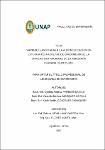Variables asociadas a la automedicación en estudiantes Facultad de Enfermería de la Universidad Nacional de la Amazonía Peruana Iquitos - 2018

View/
Date
2019Author
Marquez Asipali, Graciela Melissa
Gonzales Canaquiri, Kadia Smith
Paredes Dávila, Cynthia Andrea
Metadata
Show full item recordAbstract
El objetivo fue determinar la asociación entre las variables: edad, sexo, estado
civil, ingreso económico familiar, nivel de estudios y la automedicación en
estudiantes de la Facultad de Enfermería de la Universidad Nacional de la
Amazonía Peruana, Iquitos-2018. El método fue el cuantitativo, el diseño no
experimental de tipo correlacional y transversal. La población fueron 274
estudiantes y la muestra 160 estudiantes. El muestreo fue probabilístico aleatorio
estratificado. La técnica fue la encuesta. El instrumento fue el cuestionario para
medir las variables asociadas y automedicación, (Validez 97,2% y Confiabilidad
86,3%). Los datos fueron analizados con el programa SPSS 23.0. La prueba
estadística inferencial fue el Chi Cuadrado (X2), con α=0,05 y nivel de confianza
de 95%. Los resultados fueron: el 73,1% (117) estudiantes de menor de edad; el
78,1% (125) de sexo femenino; el 93,1% (149) en unión civil no estable; el
74,4% (119) con mayor ingreso económico familiar (mayor a S/.930.00 nuevos
soles), y el 61,2% (98) fueron de primer y segundo nivel. El 55,0% (88)
evidenciaron automedicación leve, el 31,2% (50) evidenciaron automedicación
moderada, el 7,5% (12) no evidenciaron automedicación, y el 6,3% (10)
evidenciaron automedicación severa. Conclusión: Se encontró asociación
estadística significativa entre la edad (p=0.028); sexo (p=0,000); estado civil
(p=0,012); ingreso económico familiar (p=0,005), y el nivel de estudio
(p=0,001) la automedicación en estudiantes de la Facultad de Enfermería de la
Universidad Nacional de la Amazonía Peruana de Iquitos 2018. The Objetive was to determine the association between the variables: age, sex,
marital status, family economic income, level of studies and self-medication in
students of the Faculty of Nursing of the National University of the Peruvian
Amazon, Iquitos-2018. The method was quantitative, the non-experimental
desing of correlational and transversal type. The population was 274 students
and it shows 160 students. The sampling was stratified random probabilistic. The
techniques were the survey, the instrument was the questionnaire on associated
variables and self-medication (Validity 97,2% and Reliability 86,3%). The data
was analyzed with the SPSS 23.0 program. The inferential statistical test was
Chi Square (X2), with α= 0,05 and 95% confidence level. We found: the 73,1%
(117) younger students, the 78,1% (125) female; the 93,1% (149) with nonstable
civil union; the 74,4% (119) with greater family economic income (greater
than S/. 930.00 new suns), and the 61,2% (98) were first and second level; the
55,0% (88) showed mild self-medication; the 31,2% (50) showed moderate selfmedication;
the 7,5% (12) showed no self-medication; and the 6,3% (10) showed
severe self-medication. Conclusion: A statistically significant association was
found between age (p=0,028); sex (p=0,000); marital status (p=0,012); family
economic income (p=0,005); and the level of study (p=0,001) self-metication in
students of the Faculty of Nursing of the National University of the Peruvian
Amazon of Iquitos 2018.
Collections
- Tesis [251]
The following license files are associated with this item:

